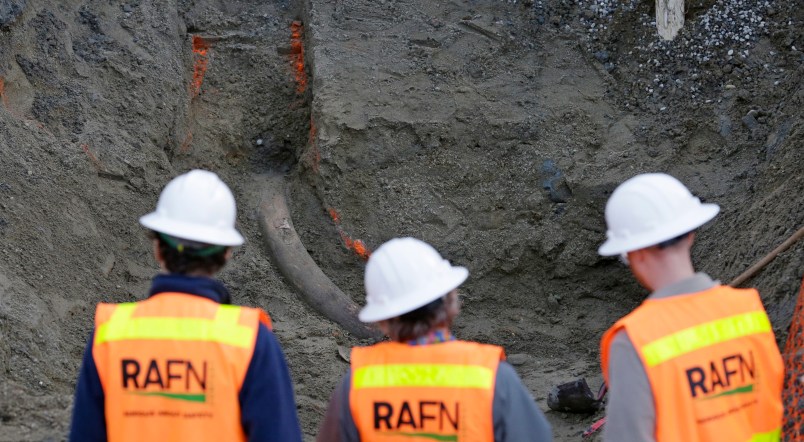SEATTLE (AP) — The mammoth tusk found this week at a construction site appears to be the largest and most intact mammoth fossil ever uncovered in the Seattle area, experts say.
Scientists at the Burke Museum of Natural History and Culture say the fossil dates back at least 16,000 years when ice swept through the Seattle area.
Although it’s possible the paleontologists who began digging out the fossil on Thursday will find more than just a tusk, experts doubt that will happen.
Mammoth elephants lived all over the United States and Europe in ancient times, but finding a tusk or any part of those animals is rare, said Jack Horner of the Museum of the Rockies and Montana State University.
“We don’t find them every year or even every five years,” said Horner, one of the nation’s most famous paleontologists.
In most cases, artifacts found at construction sites are destroyed by equipment before anyone even notices them, Horner said.
The fate of this mammoth tusk was entirely up to the landowner, because Washington has no state laws governing finds of this type. Horner said that is true anywhere in the United States.
“Americans like their private land,” he said, adding that Americans don’t like to pass laws putting restrictions on owners of private land, even to protect history.
Allyson Brooks, the Washington state preservation officer, said the situation would be different if construction workers had found human remains or other items of archaeological value because Washington state has laws for those situations.
With paleontological finds, the landowner can do whatever he or she wants — sell it, destroy it, donate it or ignore it, Brooks said.
This time, the landowner decided to donate the tusk to the Burke Museum, just as Horner hoped would happen.
It’s a relatively rare find and should be preserved for educational reasons, so children will know mammoth elephants once lived in Seattle, he said.
“A lot of times, people think these things are worth a lot of money,” Horner said. Their true value is educational, not what someone can sell a tusk for on eBay, he said.
As paleontologists and graduate students began carefully digging away the dirt around the tusk on Thursday afternoon, Julie Stein, executive director of the Burke Museum, said AMLI Residential has been wonderful to work with.
Scott Koppelman, senior vice president of AMLI Residential, said after contractors found the fossil buried about 25 to 30 feet below street level, the company turned quickly to the museum for assistance.
He said the company’s first response when hearing of the find was the community benefit.
“The excavation will cause us some construction delay, but the scientific and educational benefits of this discovery clearly outweigh the costs and delay,” Koppelman said. “This is an exciting discovery for our local Northwest history.”
In 2004, Washington state halted construction on a section of a major bridge project, on which $58 million had already been spent, at the request of the Lower Elwha Klallam Tribe after remains of an ancient Indian village and burial ground were discovered.
Discoveries of animal remains from the Ice Age are less common than human remains in western Washington. Preservation of bone and tusks depends on the environmental conditions, such as the water table, the acidity of the soil and how deeply the object was buried, Brooks said.
“A lot of time, teeth preserve better than other bones,” she said, likening tusks to teeth. She said teeth and tusks are what she and the scientists she works with consider “biological rock.”
The last big find of an ancient animal of this sort in western Washington happened in 1977, when a mastodon tusk was found near Sequim, Wash., on the Olympic Peninsula.
Mammoths and mastodons are related and probably roamed the Earth around the same time. Both were very large and hairy. Mammoths and modern-day elephants are members of the same biological family.
Scientists at the Burke believe this tusk came from a Columbian mammoth, which is the Washington state fossil. The tusk, which could be as large as 8 feet long, is expected to be the largest and most intact mammoth tusk ever found in the Seattle area.
Gov. Jay Inslee did not wish to comment on the tusk discovery, but a member of his team had something to say.
“This has turned every adult in Seattle back into a 10-year-old,” said the governor’s spokeswoman, Jaime Smith.
____
Associated Press writer Phuong Le contributed to this story.
____
Contact Donna Blankinship at https://twitter.com/dgblankinship.
Copyright 2014 The Associated Press. All rights reserved. This material may not be published, broadcast, rewritten or redistributed.










